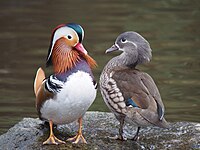
Photo from wikipedia
Sex reversal, a mismatch between phenotypic and genetic sex, can be induced by chemical and thermal insults in ectotherms. Therefore, climate change and environmental pollution may increase sex‐reversal frequency in… Click to show full abstract
Sex reversal, a mismatch between phenotypic and genetic sex, can be induced by chemical and thermal insults in ectotherms. Therefore, climate change and environmental pollution may increase sex‐reversal frequency in wild populations, with wide‐ranging implications for sex ratios, population dynamics, and the evolution of sex determination. We propose that reconsidering the half‐century old theory “Witschi's rule” should facilitate understanding the differences between species in sex‐reversal propensity and thereby predicting their vulnerability to anthropogenic environmental change. The idea is that sex reversal should be asymmetrical: more likely to occur in the homogametic sex, assuming that sex‐reversed heterogametic individuals would produce new genotypes with reduced fitness. A review of the existing evidence shows that while sex reversal can be induced in both homogametic and heterogametic individuals, the latter seem to require stronger stimuli in several cases. We provide guidelines for future studies on sex reversal to facilitate data comparability and reliability.
Journal Title: BioEssays
Year Published: 2022
Link to full text (if available)
Share on Social Media: Sign Up to like & get
recommendations!